Sardar Vallabhbhai Patel: 10 Defining Moments That Built India’s Unity & Strength
🏛️ Introduction: The Iron Will of Sardar Vallabhbhai Patel
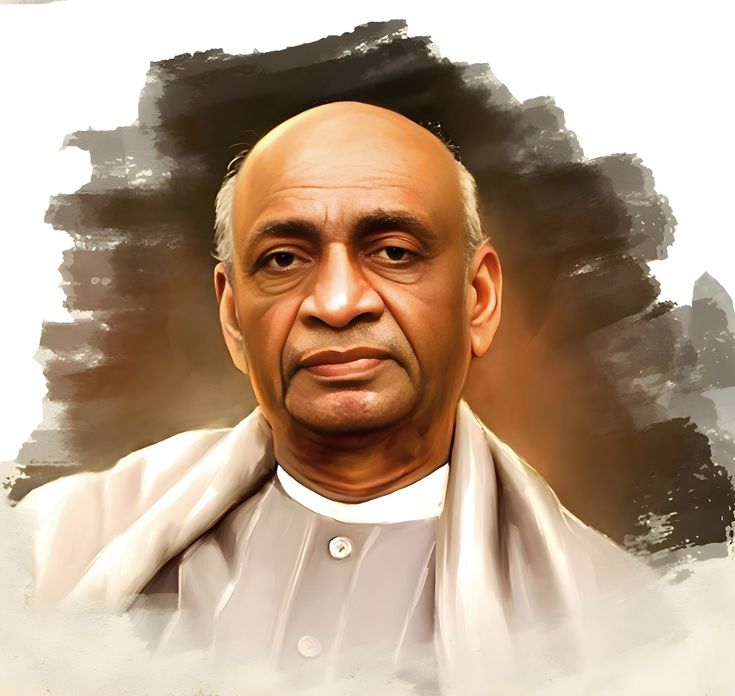
In the vast tapestry of India’s freedom struggle, few names shine with the clarity, conviction, and courage of Sardar Vallabhbhai Patel. Born on 31 October 1875 in Nadiad, Gujarat, he emerged from humble beginnings to become one of the most formidable architects of independent India. Known as the “Iron Man of India,” Sardar Vallabhbhai Patel was not just a political leader—he was a unifier, a strategist, and a symbol of national pride.
Raised in a farming family, Sardar Vallabhbhai Patel understood the pulse of rural India. His early life was marked by resilience and self-reliance. Despite limited resources, he pursued education with determination, eventually traveling to England to study law at Middle Temple. Upon returning to India, he established himself as a successful barrister in Ahmedabad. But destiny had greater plans for Sardar Vallabhbhai Patel—plans that would intertwine his life with the soul of a nation yearning for freedom.
The turning point came in 1917 when Sardar Vallabhbhai Patel met Mahatma Gandhi. Inspired by Gandhi’s philosophy of non-violence and civil disobedience, he joined the Indian National Congress and plunged into the freedom movement. His first major contribution was during the Kheda Satyagraha, where he led farmers in a non-violent protest against unjust taxation. This campaign not only brought relief to thousands but also showcased Sardar Vallabhbhai Patel’s leadership and empathy.
In 1928, the Bardoli Satyagraha catapulted him into national prominence. When the British imposed unfair taxes on the farmers of Bardoli, Sardar Vallabhbhai Patel organized a disciplined and peaceful resistance. His unwavering stand earned him the title “Sardar,” meaning chief—a name that would become synonymous with strength and integrity. Bardoli was more than a victory; it was a declaration that Sardar Vallabhbhai Patel was a force to reckon with.
Throughout the 1930s and 1940s, Sardar Vallabhbhai Patel played a pivotal role in the Congress party. He was instrumental in organizing the Civil Disobedience Movement and later the Quit India Movement. His speeches, often laced with sharp wit and deep conviction, inspired millions. Unlike many leaders who sought the limelight, Sardar Vallabhbhai Patel preferred action over applause. He believed in discipline, unity, and the power of collective will.
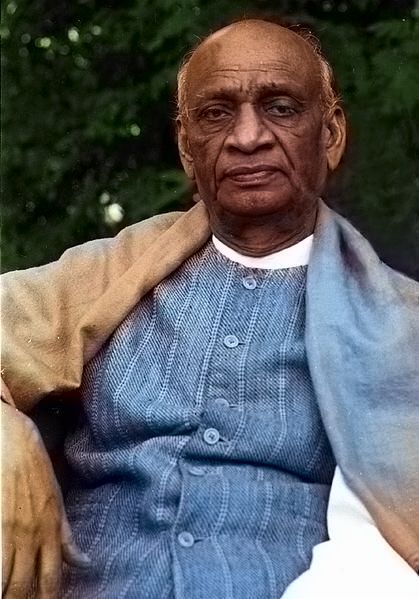
When India finally gained independence in 1947, the nation faced a daunting challenge: integrating over 562 princely states into a single union. This task fell upon Sardar Vallabhbhai Patel, who was appointed as the first Deputy Prime Minister and Home Minister of India. With a blend of diplomacy, firmness, and strategic brilliance, he convinced rulers to accede to India. His efforts prevented potential fragmentation and laid the foundation for a united nation. Without Sardar Vallabhbhai Patel, India’s map might have looked very different.
His vision extended beyond political boundaries. Sardar Vallabhbhai Patel was deeply committed to building a strong administrative framework. He played a key role in establishing the Indian Administrative Service (IAS), believing that a robust civil service was essential for governance and development. His emphasis on discipline and accountability continues to shape India’s bureaucracy to this day.
Despite ideological differences with Jawaharlal Nehru, Sardar Vallabhbhai Patel maintained a respectful working relationship. He was pragmatic, focused, and always placed national interest above personal ambition. His ability to balance firmness with compassion made him a beloved leader across communities.
On 15 December 1950, Sardar Vallabhbhai Patel passed away in Mumbai, leaving behind a legacy that continues to inspire generations. His death was mourned across the country, but his spirit lives on—in every administrative building, in every united state, and in every citizen who believes in India’s strength.
In recognition of his unparalleled contribution, the Government of India unveiled the Statue of Unity in Gujarat in 2018. Standing at 182 meters, it is the tallest statue in the world—a fitting tribute to the man who held India together. The statue is not just a monument; it is a reminder of Sardar Vallabhbhai Patel’s vision, courage, and unwavering commitment to national unity.
Today, as India navigates the complexities of modern governance, the teachings of Sardar Vallabhbhai Patel remain more relevant than ever. His belief in unity amidst diversity, his emphasis on strong institutions, and his dedication to public service offer timeless lessons. For young Indians, especially those who seek to serve the nation, Sardar Vallabhbhai Patel is more than a historical figure—he is a guiding light.
In schools, his name is taught with reverence. In political discourse, his strategies are studied. And in the hearts of millions, Sardar Vallabhbhai Patel remains a symbol of what it means to lead with integrity. His life is a testament to the idea that true leadership is not about power—it’s about purpose.
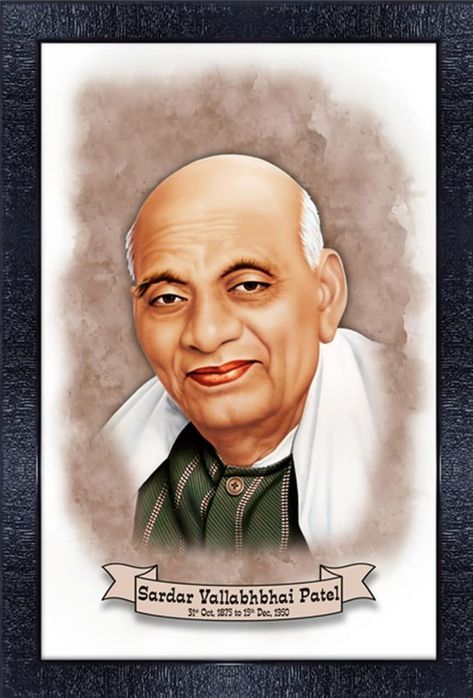
As we reflect on his journey—from a village in Gujarat to the corridors of power in Delhi—we are reminded that greatness is forged in struggle. Sardar Vallabhbhai Patel didn’t seek fame; he earned it through service. He didn’t demand loyalty; he inspired it through action. And he didn’t just dream of a united India—he built it, brick by brick, state by state.
In the annals of history, few names evoke as much respect and admiration as Sardar Vallabhbhai Patel. His legacy is etched not just in statues and speeches, but in the very fabric of India. Every time we speak of unity, discipline, and nation-building, we echo the spirit of Sardar Vallabhbhai Patel.
Table of Contents
🗣️ Historic Speech by Sardar Vallabhbhai Patel – Nagpur, 1923
🗓️ Date: 3rd September 1923
📍 Location: Nagpur, Maharashtra
👥 Audience: Thousands of satyagrahis, Congress volunteers, local citizens, and national leaders
🎯 Purpose: To address the nation after the release of imprisoned satyagrahis and to reaffirm the sanctity of the national flag and the power of non-violent resistance
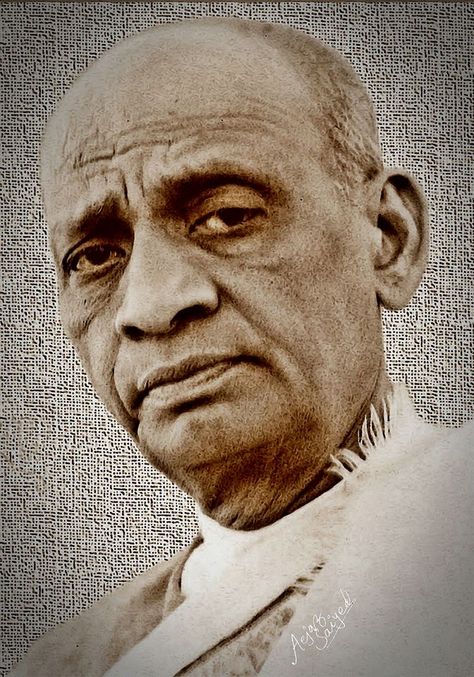
🎙️ Speech by Sardar Vallabhbhai Patel – “The Flag Is Our Soul”
Brothers and sisters,
Today, as I stand before you in the heart of Nagpur, I do not see a crowd—I see a nation rising. I see the spirit of Bharat, not in palaces or parliaments, but in your eyes, your voices, and your unwavering resolve.
They tried to silence us. They tried to crush our spirit with lathis and jails. But what they failed to understand is this: the soul of a nation cannot be imprisoned. The tricolor that we raised was not just cloth—it was our courage, our sacrifice, our unity.
When our satyagrahis marched with the flag in their hands, they were not defying an empire—they were declaring a future. A future where no foreign power would dictate our dignity. A future where every Indian, rich or poor, Hindu or Muslim, would walk with their head held high.
Some say we compromised. That we bowed to pressure. I say this: there is no compromise in courage. There is no defeat in discipline. We did not kneel—we stood taller than ever. We did not retreat—we advanced with wisdom.
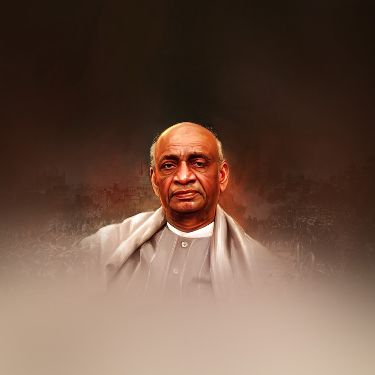
Let the world know: Sardar Vallabhbhai Patel does not speak to please rulers. I speak to awaken my people. And today, I say to every Indian—this is not the end of a protest. This is the beginning of a revolution of the soul.
Our path is not of violence, but it is not of weakness either. We shall not raise weapons, but we shall raise our voices. We shall not burn buildings, but we shall ignite minds. And if they strike us, we shall respond with silence that shakes their conscience.
The British may hold Delhi, but we hold the hearts of millions. And no empire, however mighty, can rule forever over a people who have found their purpose.
I ask you today—will you carry this flag not just in your hands, but in your hearts? Will you teach your children not just to read history, but to make it? Will you promise me that no matter how long the road, you will walk it with faith?
Because the day is not far when this flag will fly over a free India. And when that day comes, let it be said that in the streets of Nagpur, a nation remembered who it was.
Jai Hind.
🧒 1875 – The Birth of Sardar Vallabhbhai Patel: A Legacy Rooted in Soil
On 31 October 1875, in the modest town of Nadiad, Gujarat, a child was born who would one day shape the destiny of a nation. His name was Sardar Vallabhbhai Patel—a name that would echo through history as the Iron Man of India. But on that day, he was simply Vallabh, the son of a farmer, cradled not in luxury but in the values of discipline, courage, and quiet strength.
His father, Jhaverbhai Patel, was a man of grit—a farmer by profession and a soldier by spirit, having served in the army of the Queen of Jhansi. His mother, Ladbai, was the emotional anchor of the household, known for her resilience and deep-rooted wisdom. Together, they raised Vallabhbhai in a home where honor was earned, not inherited, and where every grain of food was a result of hard labor.
Growing up in a Leva Patidar family, Vallabhbhai was surrounded by the rhythms of rural life. He helped in the fields, observed the changing seasons, and learned early that nature rewards patience and perseverance. These lessons, though simple, would later shape Sardar Vallabhbhai Patel’s approach to leadership—firm, grounded, and deeply connected to the people.
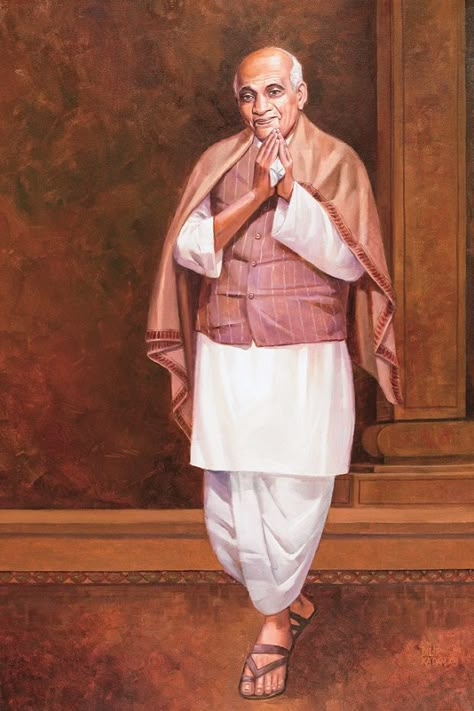
Education was not easily accessible in those days, especially for farming families. But Vallabhbhai was determined. He walked miles to attend school, often barefoot, carrying his books wrapped in cloth. He was quiet, observant, and fiercely intelligent. His teachers noted his ability to grasp complex ideas with ease, and his classmates respected his calm authority.
Despite the challenges, Vallabhbhai completed his schooling and went on to study law. He initially practiced in Ahmedabad, where he quickly gained a reputation as a sharp and fearless barrister. But his ambitions stretched beyond the courtroom. In his early thirties, he traveled to England to study at the prestigious Middle Temple Inn, completing a 36-month course in just 30 months. He graduated with honors, but even in London, he never forgot his roots.
When Sardar Vallabhbhai Patel returned to India, he didn’t chase wealth or prestige. He returned to serve. He saw the suffering of farmers, the arrogance of colonial officials, and the silent pain of a nation under foreign rule. These experiences didn’t make him bitter—they made him resolute.
His early life was not marked by grand gestures or dramatic events. It was shaped by small acts of discipline, quiet moments of reflection, and a deep connection to the soil of Gujarat. He didn’t speak much, but when he did, people listened. He didn’t seek leadership—it found him.
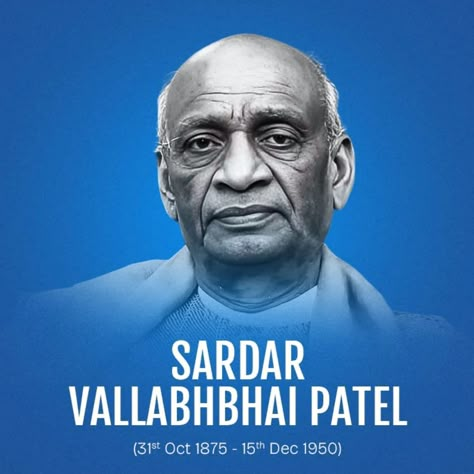
The values instilled in him during childhood—truth, duty, and unity—became the pillars of his public life. Whether leading the Bardoli Satyagraha or integrating princely states into the Indian Union, Sardar Vallabhbhai Patel always carried the spirit of Nadiad within him.
His birth in 1875 wasn’t just the arrival of a child—it was the beginning of a legacy. A legacy that would shape India’s destiny, inspire generations, and remind us that greatness often rises from the soil, not from thrones.
🎓 1890s – The Making of Sardar Vallabhbhai Patel: From Village Boy to Barrister
🎓1: A Dream Beyond the Fields
In the late 19th century, while most young men in rural Gujarat were bound to the soil, one quiet soul dared to dream beyond it. Sardar Vallabhbhai Patel, born into a humble farming family, showed early signs of brilliance and determination. Though his hands helped till the land, his mind was set on justice. He studied law informally at first—borrowing books, observing courtrooms, and preparing for exams with the same discipline he learned in the fields.
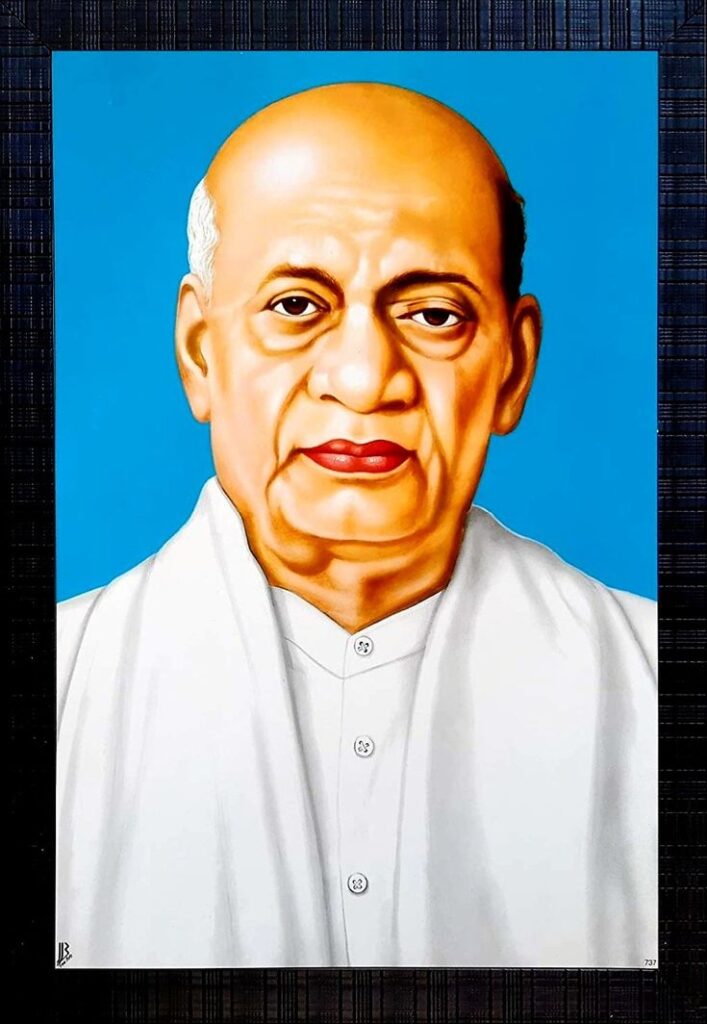
✈️2: The Journey to England
By his early 30s, Vallabhbhai had already built a modest legal practice in Ahmedabad. But he knew that to truly challenge colonial injustice, he needed to master the law at its source. So, in 1910, he made a bold move—he sailed to England to study at the prestigious Middle Temple Inn in London. It was a leap not just across oceans, but across class, culture, and colonial barriers.
🏛️3: The Scholar in a Suit
In London, Sardar Vallabhbhai Patel stood out—not for his background, but for his brilliance. He completed the 36-month law course in just 30 months, graduating at the top of his class. He wore suits, spoke fluent English, and moved through the halls of British legal tradition with quiet confidence. But beneath the polished exterior, he remained deeply rooted in Indian values. He never forgot why he came—to serve, not to shine.
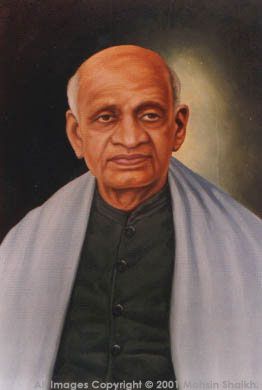
⚖️4: The Barrister of Ahmedabad
Returning to India, Sardar Vallabhbhai Patel resumed his legal career in Ahmedabad. His courtroom presence was commanding. He was known for his sharp arguments, fearless cross-examinations, and unwavering integrity. Clients trusted him. Opponents respected him. Judges listened. But what truly set him apart was his empathy—he didn’t just fight cases, he fought for people.
🌱5: Seeds of Leadership
Though he had no political ambitions at the time, Sardar Vallabhbhai Patel’s growing reputation as a man of justice and discipline drew him closer to the freedom movement. His legal mind, combined with his rural roots, made him a bridge between India’s villages and its vision for independence. The law gave him tools—but his values gave him purpose.
This phase of his life—from the dusty lanes of Gujarat to the hallowed halls of London—was not just about education or career. It was about transformation. It was the making of a man who would one day unify a divided nation with the same clarity and conviction he once brought to the courtroom.
🔥 1917 – The Rise of Sardar Vallabhbhai Patel: From Barrister to Bharat’s Backbone
🕊️1: A Spark Ignited by Gandhi
In 1917, Sardar Vallabhbhai Patel was a successful barrister in Ahmedabad—sharp, respected, and quietly ambitious. But everything changed when he heard Mahatma Gandhi speak. Gandhi’s call for truth, non-violence, and service struck a chord deep within him. It wasn’t just a speech—it was a summons. That day, Sardar Vallabhbhai Patel chose purpose over profession.
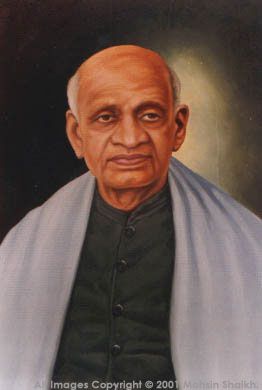
🧹2: Leading with Clean Hands
Soon after, he was elected Sanitation Commissioner of Ahmedabad. It wasn’t a glamorous role—but it was a test of leadership. Patel didn’t just issue orders—he picked up the broom himself. He cleaned streets, inspired volunteers, and proved that true leadership begins with humility. Sardar Vallabhbhai Patel showed that dignity lies in service, not status.
🌾3: The Kheda Satyagraha – Fighting for Farmers
In the same year, famine struck Kheda district. The British demanded taxes from starving farmers. Patel stepped in—not as a lawyer, but as a warrior of justice. He joined Gandhi in launching the Kheda Satyagraha, a peaceful revolt demanding tax relief. He organized villages, built unity, and stood firm against colonial arrogance. The movement succeeded—and Sardar Vallabhbhai Patel emerged as a fearless voice for the voiceless.
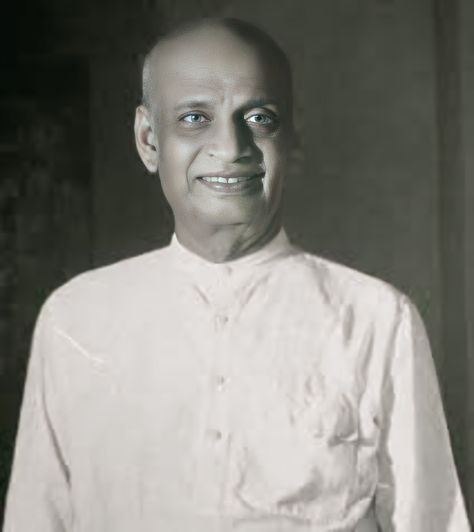
💬 Legacy of 1917
This year wasn’t just a turning point—it was a transformation. From courtroom to village square, Sardar Vallabhbhai Patel became a servant of the people. His journey in 1917 laid the foundation for every battle he would fight ahead—for Bardoli, for unity, for India.
💪 1928 – Bardoli Satyagraha: When Sardar Vallabhbhai Patel Became the Iron Shield of India
In the heart of Gujarat, in a small town called Bardoli, a storm was brewing in 1928—not of nature, but of resistance. The British Raj, blind to the suffering of Indian farmers, had imposed a cruel 22% tax hike despite floods and crop failure. The people were devastated. Their fields were dry, their granaries empty, and their spirits low. But they were not alone. A leader was about to rise—not with weapons, but with will. His name was Sardar Vallabhbhai Patel.
🌾1: The Pain of the People
The farmers of Bardoli were no strangers to hardship. They had faced droughts, debts, and the daily grind of colonial exploitation. But the 1928 tax hike was a breaking point. How could they pay when their crops had failed? How could they feed their families and still satisfy the greed of an empire?
Villagers gathered in temples, under banyan trees, and in dusty courtyards. They spoke in hushed tones, afraid yet angry. They needed someone who could speak for them—someone who understood their pain and had the courage to challenge the British. That someone was Sardar Vallabhbhai Patel.
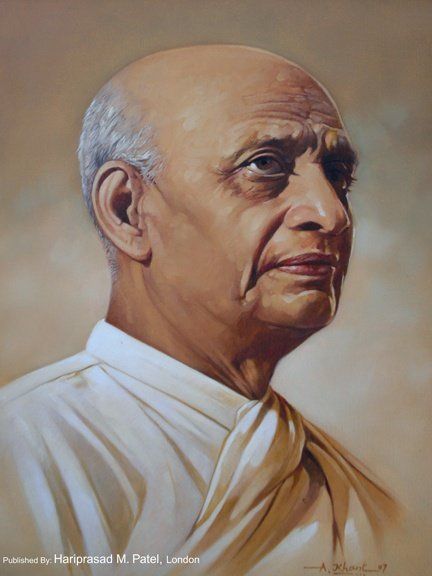
✊2: The Call to Resist
When the farmers approached Patel, he didn’t rush to the podium. He listened. He walked through the villages, spoke to the elders, and felt the pulse of the people. He didn’t promise miracles—he promised unity. And that was more powerful than any weapon.
Sardar Vallabhbhai Patel laid out a plan: no one would pay the unjust tax. Not a single rupee. But there would be no violence, no chaos. Only discipline, silence, and strength. He trained volunteers, formed village committees, and created a communication network that kept every villager informed and inspired.
This wasn’t just a protest—it was a movement. And Patel wasn’t just a leader—he was a shield.
🛑3: The Empire Strikes Back
The British were furious. They thought the villagers would break. They didn’t. So the government retaliated. Lands were seized. Homes were auctioned. Cattle were taken. Families were thrown into the streets. But Bardoli didn’t flinch.
Why? Because Sardar Vallabhbhai Patel stood with them. He didn’t hide in offices or behind slogans. He was in the fields, in the meetings, in the hearts of the people. His calm presence gave them courage. His strategy gave them hope.
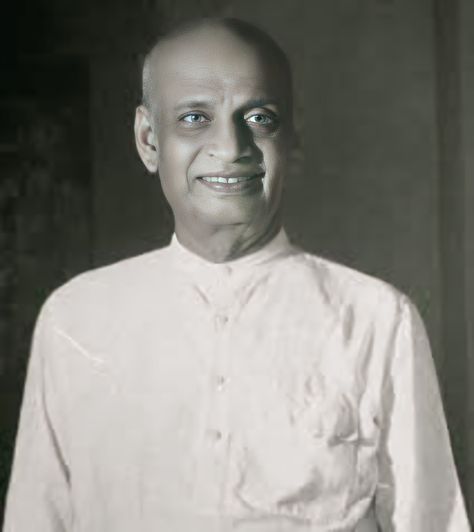
He ensured that every act of British cruelty was documented. He sent reports to newspapers, to Congress leaders, and to the world. Bardoli became a symbol—not of suffering, but of strength.
👑4: The Birth of “Sardar”
As the movement gained momentum, pressure mounted on the British. The media began to question the morality of the tax. National leaders rallied behind Bardoli. And finally, the government relented. The tax hike was withdrawn. Confiscated lands were returned. The people had won.
But the real victory was emotional. The farmers, overwhelmed with gratitude, gave Vallabhbhai a new name: “Sardar”, meaning Chief. It wasn’t a political title—it was a badge of honor. A symbol of trust, earned not through speeches, but through sacrifice.
From that day on, Sardar Vallabhbhai Patel was no longer just a barrister or a leader. He was the people’s Sardar—their protector, their voice, their strength.
🔥 5: A National Hero Emerges
The Bardoli Satyagraha didn’t just change Gujarat—it changed India. It proved that non-violent resistance could defeat colonial power. It showed that rural India was not weak—it was awake. And it introduced the nation to a new kind of leader: one who didn’t seek fame, but earned it through service.
Sardar Vallabhbhai Patel became a national icon. His name was spoken in every village, his story told in every home. He had shown that unity was stronger than fear, and that discipline could shake an empire.
🔥 Part 6: The Legacy of Bardoli
Bardoli wasn’t just a chapter in history—it was a blueprint for revolution. It taught India how to fight without violence, how to lead without ego, and how to win without hate.
For Sardar Vallabhbhai Patel, Bardoli was just the beginning. The same clarity, courage, and compassion he showed here would later help him unify 562 princely states into one India. But it was in Bardoli that his legend was born.
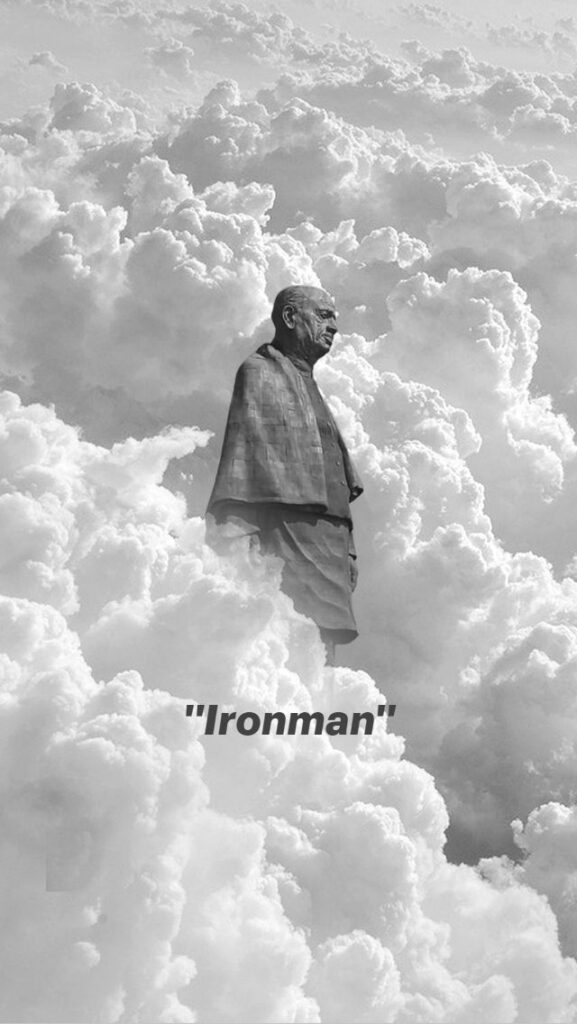
Even today, when we speak of leadership, we remember Bardoli. When we speak of unity, we remember Bardoli. And when we speak of Sardar Vallabhbhai Patel, we remember the man who turned a tax revolt into a national awakening.
📝 Final Reflection
In a world full of noise, Sardar Vallabhbhai Patel led with silence. In a time of fear, he led with faith. And in a land divided by caste, class, and colonialism, he led with unity.
The Bardoli Satyagraha was not just a protest—it was a promise. A promise that India would rise. That its people would stand. And that leaders like Sardar Vallabhbhai Patel would never let them fall.
🏛️ 1930s–1940s: Sardar Vallabhbhai Patel — The Strategist Who Steeled India’s Resolve
As India’s freedom struggle intensified in the 1930s and 1940s, one man stood like a pillar of discipline, strategy, and silent strength—Sardar Vallabhbhai Patel. While others stirred crowds with fiery speeches, Patel worked behind the scenes, building the backbone of resistance. These two decades saw him evolve from a regional hero into a national architect of India’s destiny.
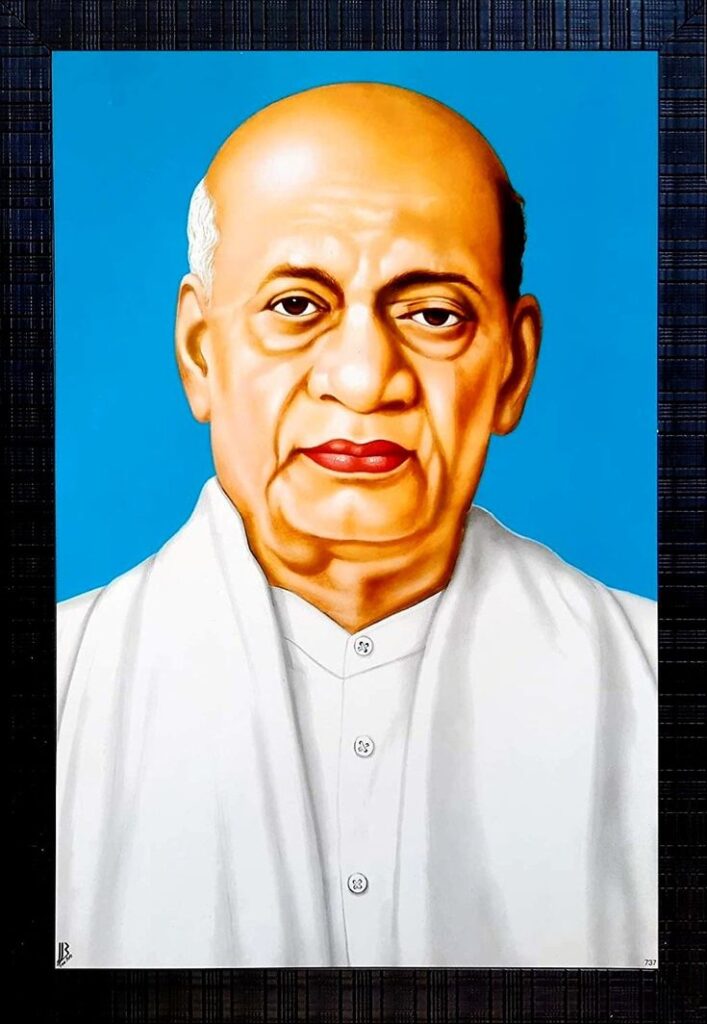
✊1: The Civil Disobedience Movement — Patel, the Iron Organizer
In 1930, when Mahatma Gandhi launched the Civil Disobedience Movement, the nation erupted in defiance. But mass movements need more than slogans—they need structure. That’s where Sardar Vallabhbhai Patel stepped in.
He wasn’t just a supporter—he was a key strategist. He mobilized volunteers, coordinated protests, and ensured that every act of resistance was disciplined and non-violent. In Gujarat, he led salt satyagrahas, picketed liquor shops, and inspired thousands to boycott British goods.
Even when arrested, Sardar Vallabhbhai Patel remained calm. His silence in jail was louder than any speech. He believed that true freedom required not just courage, but character. And he lived that belief every day.
🔥2: Quit India Movement (1942) — Patel’s Moment of Fire
By 1942, the British were still clinging to power, and World War II had drained India’s patience. The Quit India Movement was Gandhi’s final call for complete independence. And once again, Sardar Vallabhbhai Patel was at the frontlines—not just in spirit, but in action.
At the historic Gowalia Tank meeting in Bombay, Patel stood beside Gandhi and Nehru as the Quit India resolution was passed. His speech that day was electric—firm, fearless, and full of fire. He told the British: “Leave India to God. If that is too much, then leave her to anarchy.”
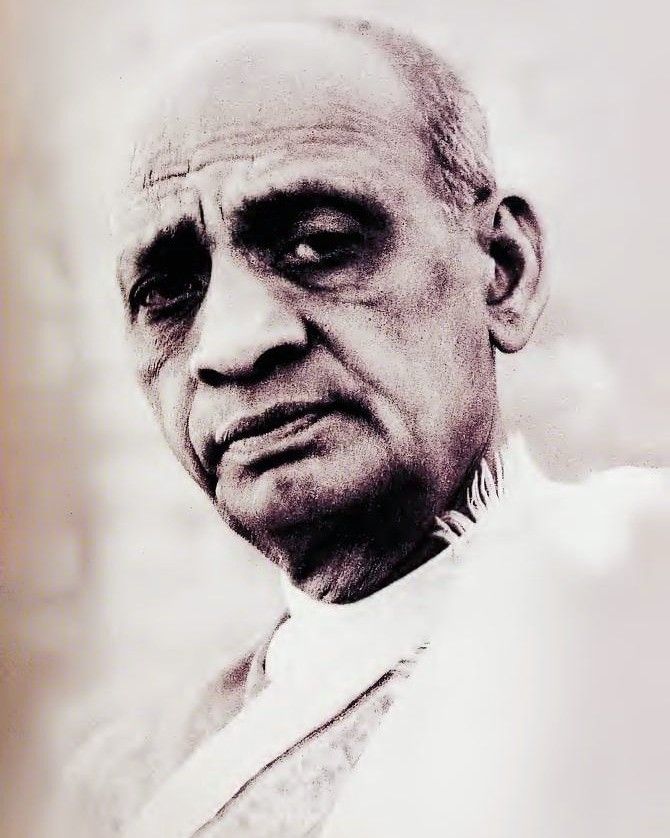
Within hours, he was arrested. But the movement had already ignited. Across India, protests erupted, and underground networks formed. Though behind bars, Sardar Vallabhbhai Patel’s influence guided the resistance. His earlier groundwork—building local leadership, training volunteers, and instilling discipline—kept the movement alive even in chaos.
🕊️3: The Silent Bridge — Hindu-Muslim Unity & National Integration
While the streets burned with protest, Sardar Vallabhbhai Patel worked on something even more fragile—India’s unity. He knew that freedom meant nothing if the nation was divided. So he quietly began building bridges between communities.
He reached out to Muslim leaders, appealed for communal harmony, and emphasized shared struggle over sectarian strife. His message was simple: “India belongs to all who love her.”
Even as Partition loomed, Sardar Vallabhbhai Patel remained committed to national integration. He believed in a united India—not just geographically, but emotionally. His efforts during this time laid the foundation for his later role in integrating princely states after independence.
🛡️4: The Iron Within
What made Sardar Vallabhbhai Patel different wasn’t just his strategy—it was his soul. He didn’t seek headlines. He didn’t crave applause. He believed in quiet strength. In every Congress session, he was the one who brought order. In every crisis, he was the one who brought calm.
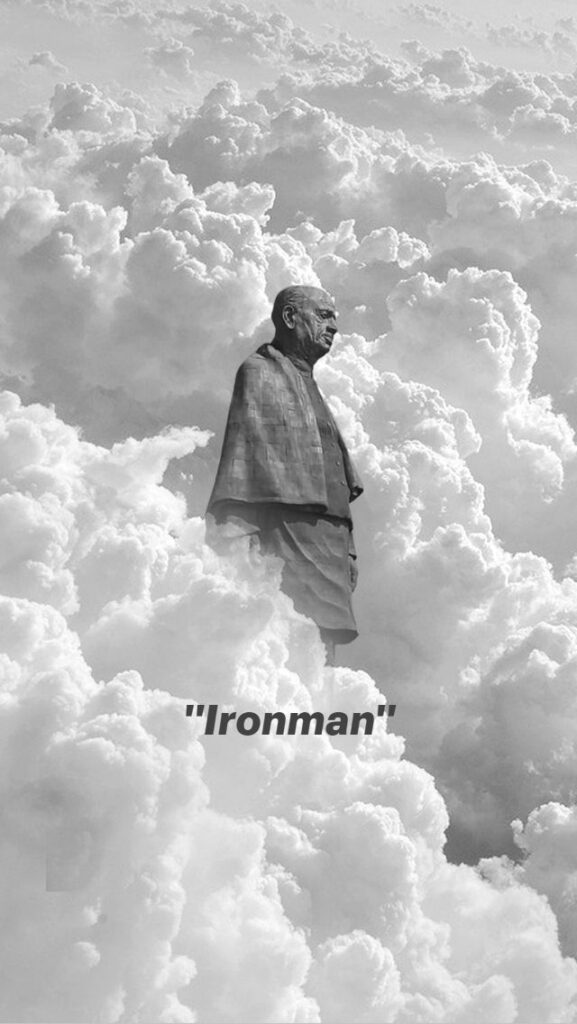
He was the man who could disagree with Gandhi, yet never disrespect him. The man who could challenge Nehru, yet always protect the party. He was the spine of the Congress—firm, flexible, and unbreakable.
🛡️5: Legacy of Leadership
The 1930s and 1940s were the crucible years of India’s freedom struggle. And in that fire, Sardar Vallabhbhai Patel emerged as steel. He wasn’t just a freedom fighter—he was a nation builder in waiting.
His leadership during the Civil Disobedience and Quit India movements proved that India didn’t just need dreamers—it needed doers. His advocacy for Hindu-Muslim unity proved that India didn’t just need freedom—it needed healing.
And when independence finally came, it was Sardar Vallabhbhai Patel who would take on the toughest task of all—uniting a divided land into one India.
📝 Final Reflection
In the chaos of revolution, Sardar Vallabhbhai Patel was the calm. In the noise of politics, he was the clarity. And in the heart of India, he was the iron that held it all together.
The 1930s and 1940s weren’t just decades of protest—they were the years when Patel’s quiet leadership shaped the soul of a free India.
🇮🇳 1947 – Sardar Vallabhbhai Patel: The Architect of India’s Unity
When India finally broke free from the chains of British rule in 1947, the air was filled with celebration—but also uncertainty. The joy of independence came with the chaos of Partition, communal violence, and a fractured map. Amid this storm, one man stepped forward—not to bask in glory, but to hold the nation together. That man was Sardar Vallabhbhai Patel.
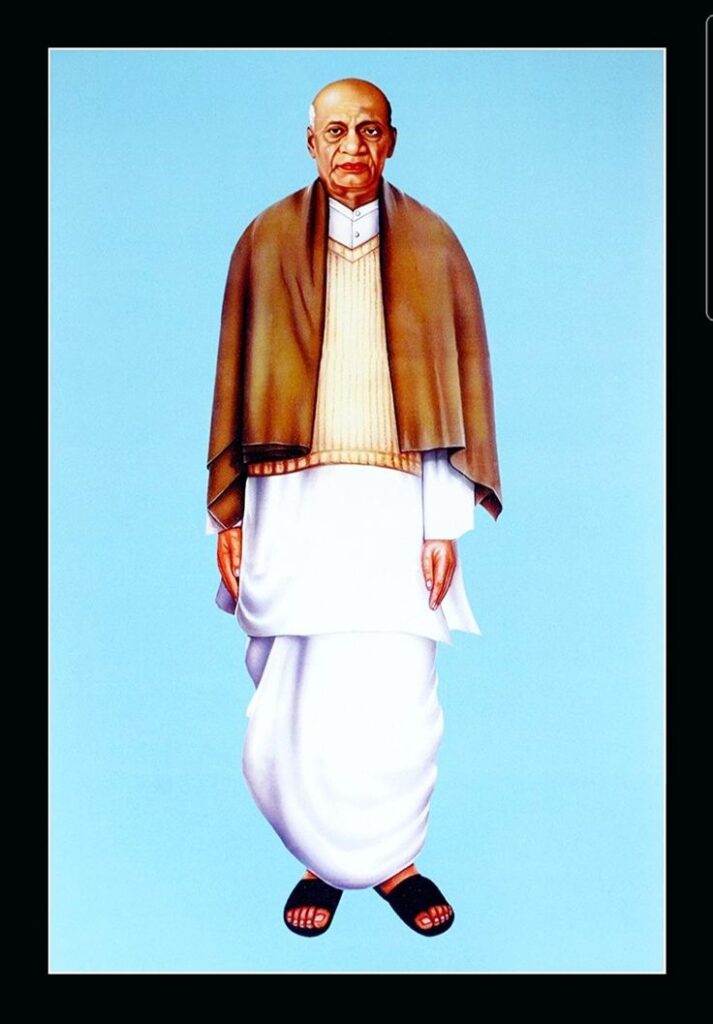
🏛️ 1: The First Duty — Deputy Prime Minister & Home Minister
On 15 August 1947, as the tricolor rose over a free India, Sardar Vallabhbhai Patel took charge as the first Deputy Prime Minister and Home Minister of the country. It wasn’t a ceremonial role—it was a battlefield of decisions.
India was bleeding. Refugees poured across borders. Communal riots raged. The administration was in shambles. But Patel didn’t flinch. He rolled up his sleeves and got to work. His mission was clear: stabilize the nation, secure its borders, and unify its heart.
🗺️ 2: 562 Pieces of a Puzzle — The Princely States
At the time of independence, India wasn’t one country—it was a patchwork of 562 princely states, each with its own ruler, flag, and ambition. Some wanted to join India. Others wanted to remain independent. A few even flirted with joining Pakistan.
The British had left it to the princes to decide. But Patel knew: a divided India would be a doomed India.
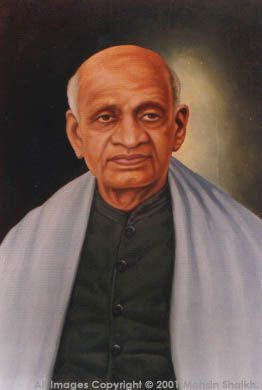
So, with the help of V.P. Menon, he launched a diplomatic mission unlike any in history. He wrote letters, held meetings, and made personal appeals. He didn’t threaten—he reasoned. He didn’t beg—he persuaded. And when needed, Sardar Vallabhbhai Patel stood firm.
🤝3: Diplomacy with a Spine
Patel’s genius lay in his balance. He offered respect to the princes—but made it clear that India’s unity was non-negotiable. He gave them dignity, but not dominance. He promised them privy purses and ceremonial roles—but demanded loyalty to the Indian Union.
Most agreed. Some resisted. But Sardar Vallabhbhai Patel never blinked.
When the Nawab of Junagadh acceded to Pakistan despite a Hindu-majority population, Patel sent in troops and held a plebiscite. The people chose India.\
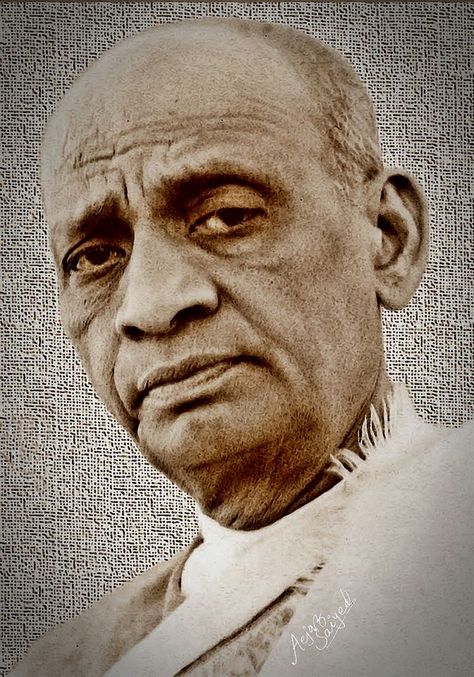
When Hyderabad’s Nizam delayed, Patel launched Operation Polo—a swift, bloodless military action that brought the state into the Union.
When Kashmir faced invasion, Patel stood ready to act—but deferred to Nehru’s diplomatic path.
Through it all, Sardar Vallabhbhai Patel remained the iron spine of India’s integration.
🛡️4: Unity Without Bloodshed
What makes Patel’s achievement historic is not just the outcome—but the method. He unified a subcontinent without a civil war. No empire in history had ever done that. He didn’t use force as a first option. He used dialogue, trust, and resolve.
In just over a year, India went from 562 fragments to one nation. No other leader could have done it with such speed, clarity, and control.
🧭5: The Visionary Beyond Borders
Sardar Vallabhbhai Patel wasn’t just thinking about maps—he was thinking about the future. He believed that a strong India needed a strong center. He laid the foundation for the Indian Administrative Service (IAS), ensuring that governance would be professional, impartial, and rooted in discipline.
He also emphasized national integration beyond geography—urging citizens to rise above caste, religion, and region. For Patel, unity wasn’t just about land—it was about identity.
🕊️ 6: The Quiet Hero of Independence
While others gave speeches, Sardar Vallabhbhai Patel gave India structure. While others debated, he delivered. He didn’t seek the spotlight—but history shines it on him anyway.
His work in 1947 wasn’t glamorous—it was gritty. It wasn’t loud—it was lasting. And it wasn’t just political—it was deeply personal. He saw India not as a project, but as a promise.
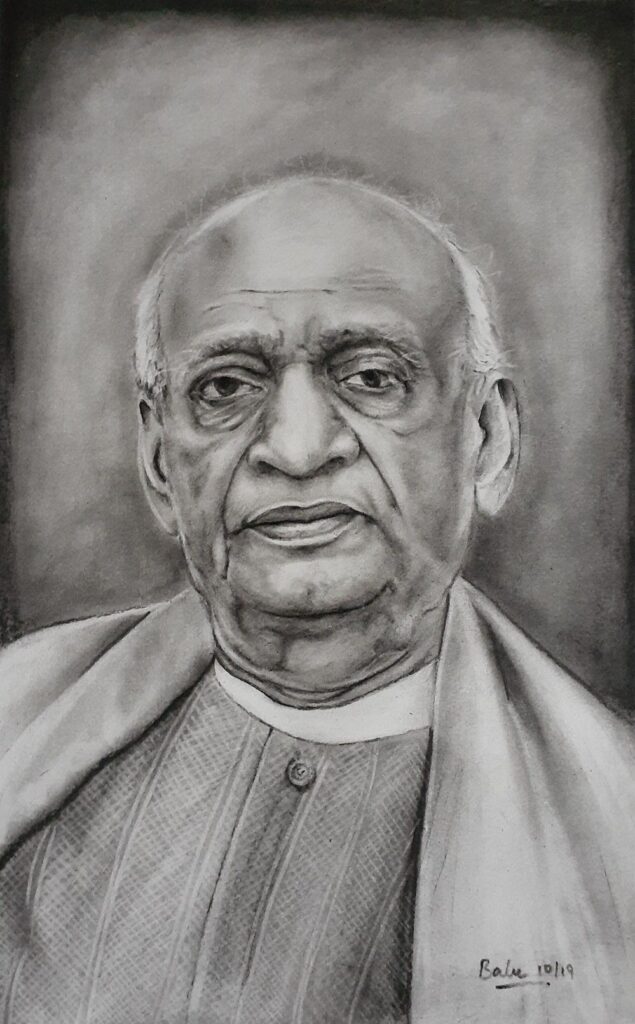
📝 Final Reflection
In the story of India’s independence, Sardar Vallabhbhai Patel is the chapter that holds the book together. Without him, there might have been freedom—but not unity. There might have been a flag—but not a nation.
He didn’t just build India’s map—he built its backbone.
🛡️ 1947–1950 – Sardar Vallabhbhai Patel: The Iron Architect of Nation Building
When India gained independence in 1947, the tricolor flew high—but the ground beneath was fragile. The country was bleeding from Partition, riddled with communal violence, and scattered into hundreds of princely states. Amid this chaos, one man stepped forward—not with fanfare, but with fierce resolve. That man was Sardar Vallabhbhai Patel.
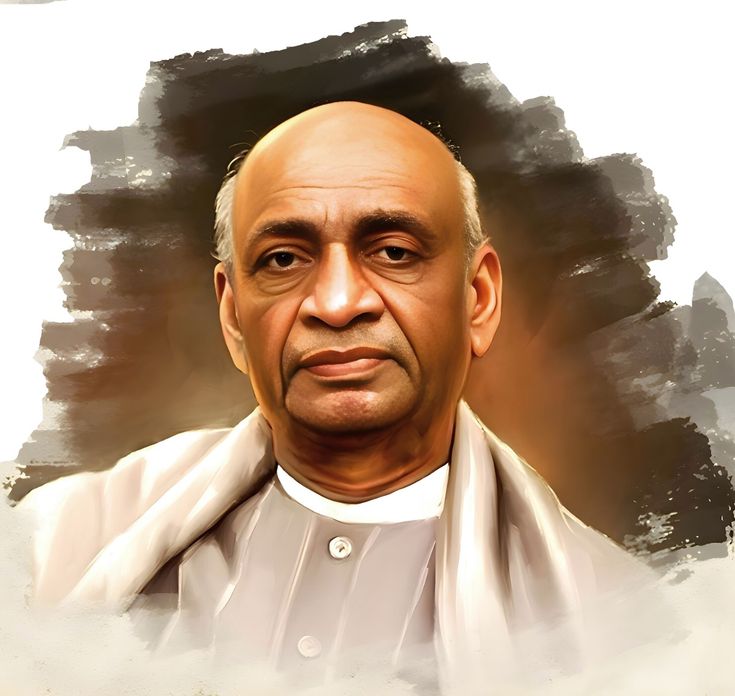
🏛️1: The Administrator India Needed
As India’s first Deputy Prime Minister and Home Minister, Sardar Vallabhbhai Patel had no time for celebration. His desk wasn’t filled with ceremonial files—it was stacked with crises. Refugee resettlement, law and order, and the integration of princely states all demanded urgent action.
But Patel didn’t panic. He acted. With calm precision, he began building the administrative backbone of India. He believed that freedom without order was chaos. And so, he turned his attention to the one institution that could hold the country together—the civil services.
🧱 2: Strengthening the Steel Frame
Many leaders wanted to dismantle the colonial bureaucracy. But Sardar Vallabhbhai Patel saw its potential. He called the Indian Civil Services (ICS) the “steel frame” of India. Without it, he warned, the country would collapse.
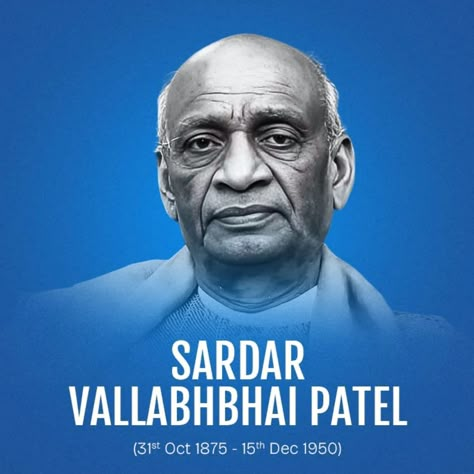
He transformed the ICS into the Indian Administrative Service (IAS)—a new force, loyal not to the British Crown, but to the Indian Constitution. He ensured that officers were selected on merit, trained with discipline, and empowered to serve the people without fear or favor.
This wasn’t just policy—it was vision. Patel knew that a strong, impartial administration was the key to nation building. And he made it happen.
🏛️3: A Strong Center for a Strong India
India in 1947 was a patchwork of provinces, princely states, and linguistic identities. There was a real fear that the country could fracture. Sardar Vallabhbhai Patel believed that only a strong central government could hold this vast, diverse land together.
He pushed for a Constitution that gave the Union government enough power to maintain unity, enforce law, and protect national interests. He wasn’t against federalism—but he knew that in a newly born nation, too much decentralization could lead to disintegration.
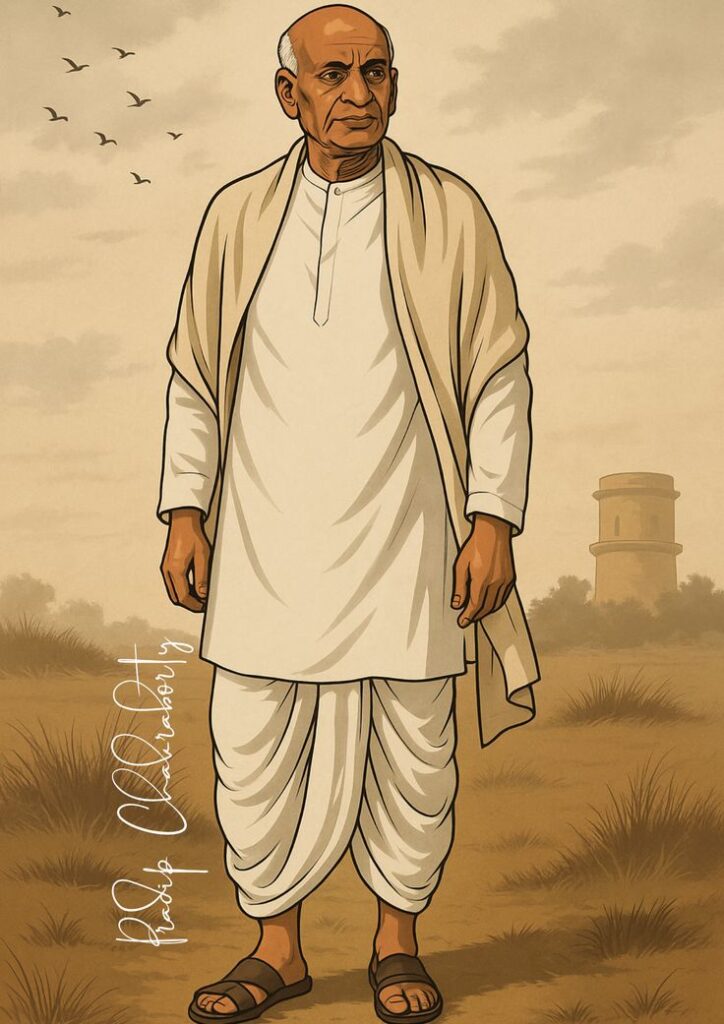
His stance wasn’t always popular—but it was prophetic. Today, India’s unity owes much to the central structure Patel helped shape.
🤝4: Patel and Nehru — Unity Beyond Ideology
Sardar Vallabhbhai Patel and Jawaharlal Nehru were very different men. Nehru was idealistic, global in outlook, and leaned toward socialism. Patel was pragmatic, rooted in Indian soil, and focused on order and security.
They clashed—on Kashmir, on China, on the role of bureaucracy. But they never let their differences break their bond. Patel once said, “Jawaharlal is the only person who can keep India united.” And Nehru, despite disagreements, deeply respected Patel’s strength.
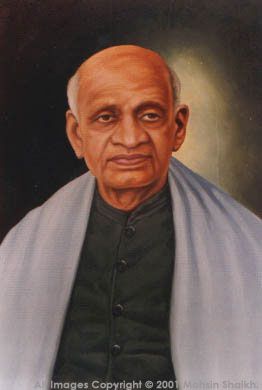
Together, they formed a balanced leadership—vision and vigilance, idealism and implementation. Their partnership wasn’t perfect, but it was powerful.
🧭5: The Final Years, The Final Gift
Between 1947 and 1950, Sardar Vallabhbhai Patel worked tirelessly—often at the cost of his health. He traveled across states, mediated conflicts, and laid the foundation for a united, functioning democracy.
He didn’t seek credit. He didn’t chase headlines. He simply did what needed to be done.
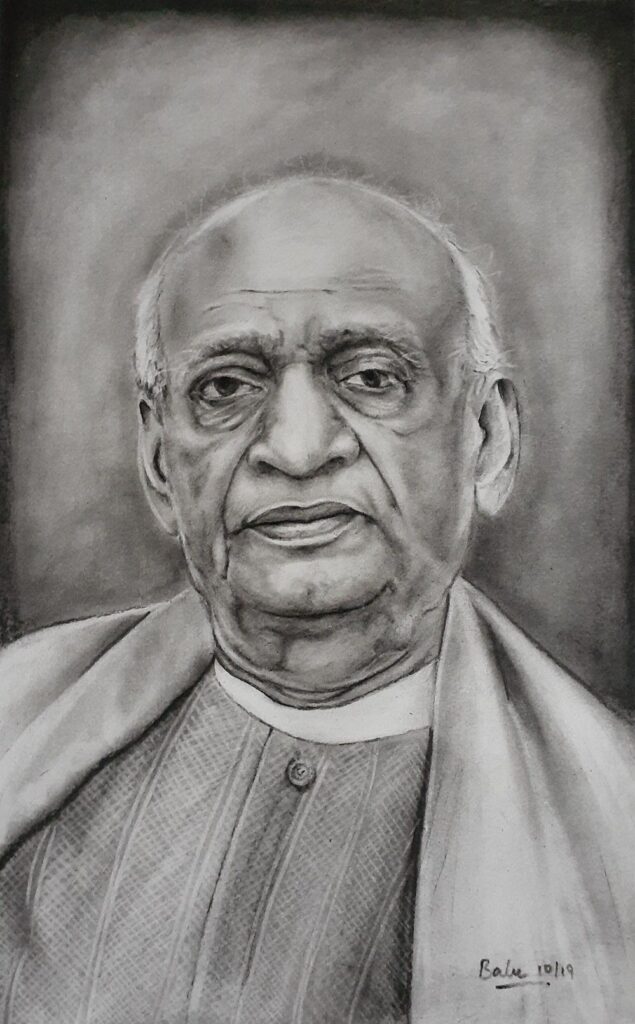
When the Constitution of India came into effect on 26 January 1950, Patel’s work was largely complete. The map was unified. The administration was in place. The center was strong. And the people had hope.
🕊️ Final Reflection: The Iron That Held India Together
Sardar Vallabhbhai Patel didn’t just fight for freedom—he fought for stability after freedom. He didn’t just dream of India—he built it, brick by brick, law by law, state by state.
From strengthening the civil services to advocating for a strong center, from working with Nehru to calming a divided land—Patel was the iron architect of India’s nationhood.
His legacy isn’t just in statues or speeches. It’s in every IAS officer who serves with integrity. It’s in every state that stands under one flag. It’s in the silent strength of a nation that didn’t fall apart—but came together.
🛡️ 1950 – Death & Legacy of Sardar Vallabhbhai Patel: The Iron That Never Rusted
🕯️1: The Final Breath of a Giant
On 15 December 1950, Sardar Vallabhbhai Patel took his last breath in Mumbai, at the age of 75. The man who had stitched India together, state by state, passed away quietly—without fanfare, without farewell speeches. But the silence that followed was deafening. India had lost its shield.
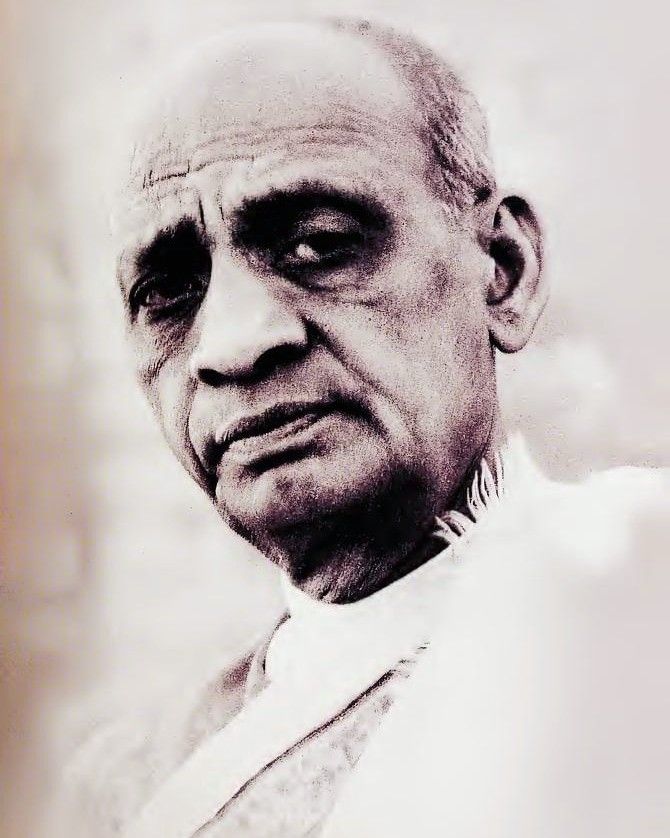
His health had been deteriorating for months. Years of tireless service, endless travel, and emotional strain had taken their toll. Yet, till the very end, Sardar Vallabhbhai Patel remained focused on India’s stability. His final days were spent ensuring that the newly independent nation didn’t fall apart.
🧠2: The Iron Man of India
The title “Iron Man of India” wasn’t given—it was earned. Through Bardoli, through the integration of 562 princely states, through his unwavering discipline and fearless decisions, Sardar Vallabhbhai Patel became the embodiment of strength.
He didn’t bend under pressure. He didn’t break under conflict. He stood firm—like iron. His leadership wasn’t loud, but it was lasting. He didn’t seek applause, but history gave it to him anyway.
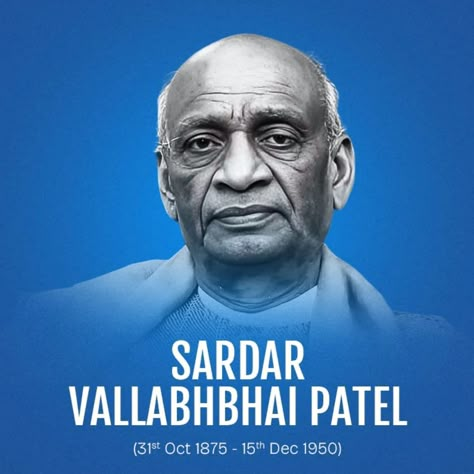
Even those who disagreed with him respected him. Nehru, despite their ideological differences, called him “the builder and defender of India.” Gandhi once said, “If I die today, Vallabhbhai will carry on.”
🗺️3: A Legacy Etched in Unity
Patel’s greatest gift to India was unity. At a time when the country could have splintered into hundreds of kingdoms, he brought them together. Through diplomacy, firmness, and vision, he convinced rulers to join the Indian Union.
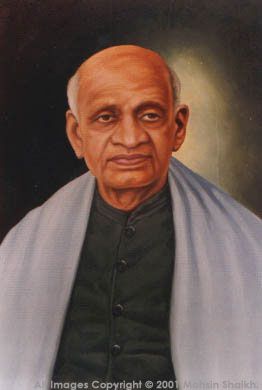
Without Sardar Vallabhbhai Patel, India’s map would look very different. Hyderabad, Junagadh, Kashmir—each was a challenge. But Patel didn’t flinch. He acted with clarity and courage.
His legacy isn’t just political—it’s emotional. He gave India a sense of wholeness. A feeling that despite our differences, we are one.
🗿4: The Statue of Unity — A Tribute That Touches the Sky
In 2018, India paid its grandest tribute to Sardar Vallabhbhai Patel—the Statue of Unity, located in Kevadiya, Gujarat, near the Narmada River. Standing at 182 meters (597 feet), it is the tallest statue in the world.
Designed by sculptor Ram V. Sutar, the statue captures Patel’s strength, resolve, and dignity. It’s not just a monument—it’s a message. A reminder that unity is India’s greatest strength.
Millions visit the site every year. Schools, families, and tourists stand before the Iron Man’s likeness, feeling the weight of his legacy. The statue isn’t just made of bronze—it’s made of pride.
🧭5: Lessons That Still Lead Us
Even decades after his death, Sardar Vallabhbhai Patel’s principles guide India. His belief in a strong center, disciplined governance, and national integration remain relevant.
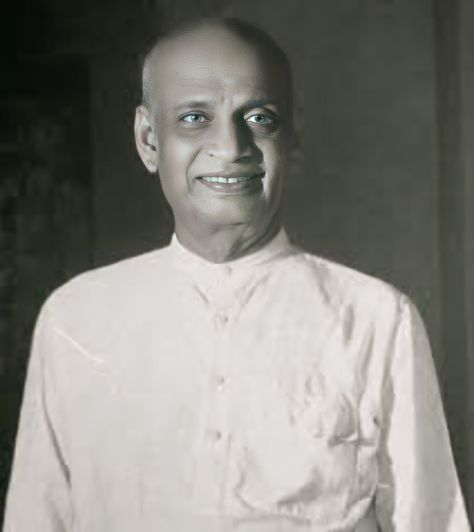
He taught us that leadership is not about popularity—it’s about responsibility. That unity is not automatic—it must be built. And that strength is not in domination—but in service.
His speeches, letters, and decisions are studied by leaders, scholars, and students. His life is a blueprint for nation-building.
🕊️ Final Reflection: The Man Who Made India Whole
Sardar Vallabhbhai Patel didn’t just live for India—he shaped it. His death in 1950 marked the end of an era, but his legacy continues to breathe through every law, every border, every citizen.
He was the iron that never rusted. The leader who never wavered. The patriot who never paused.
And today, as the Statue of Unity touches the sky, his story touches our hearts.
🌟 What Sardar Vallabhbhai Patel Is Famous For: The Iron Legacy That Built India
🗺️ Part 1: The Mastermind of Political Integration
When India gained independence in 1947, it wasn’t one nation—it was a puzzle of 562 princely states. Some wanted to join Pakistan. Others wanted to stay independent. India stood on the edge of fragmentation.
Sardar Vallabhbhai Patel stepped in—not with force, but with fierce diplomacy. He convinced, negotiated, and when needed, acted decisively. From Hyderabad to Junagadh, he brought them all into the fold. Without him, India’s map would be unrecognizable.
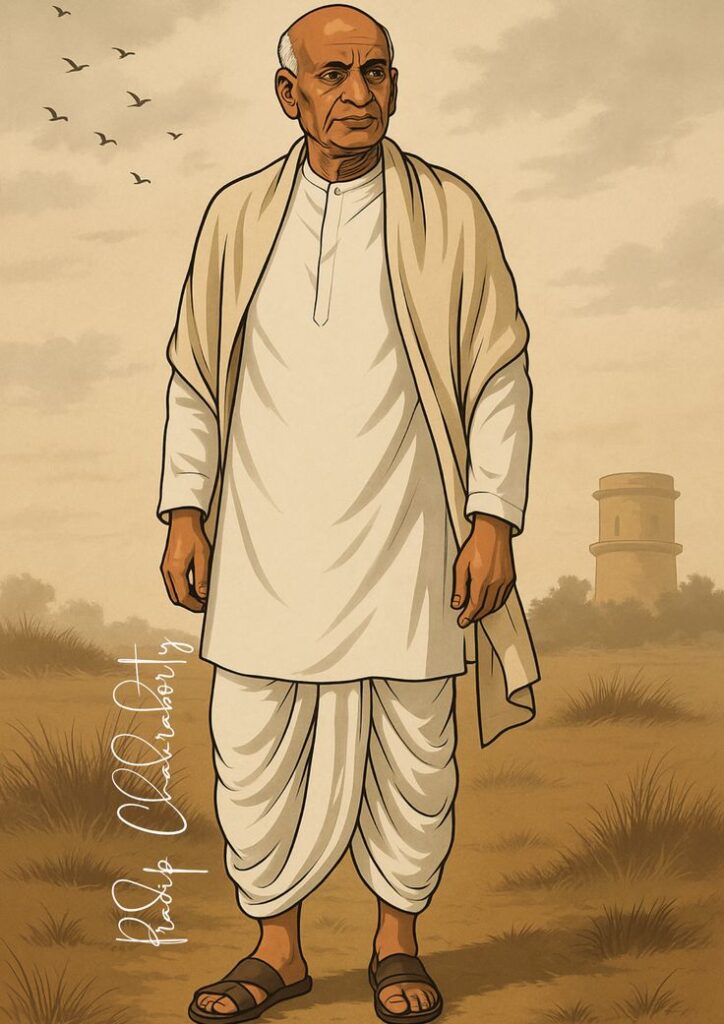
He didn’t just unify land—he unified hearts. That’s why he’s remembered as the architect of India’s political integration.
✊ Part 2: The Lion of Bardoli
In 1928, the British raised taxes in Bardoli, Gujarat, despite crop failure. Farmers were desperate. Patel didn’t give speeches—he gave them strength.
He led a non-violent tax revolt, organizing villagers with military-like discipline. The British cracked down. Patel stood taller. The movement succeeded, and the people gave him a new name: “Sardar”—the Chief.
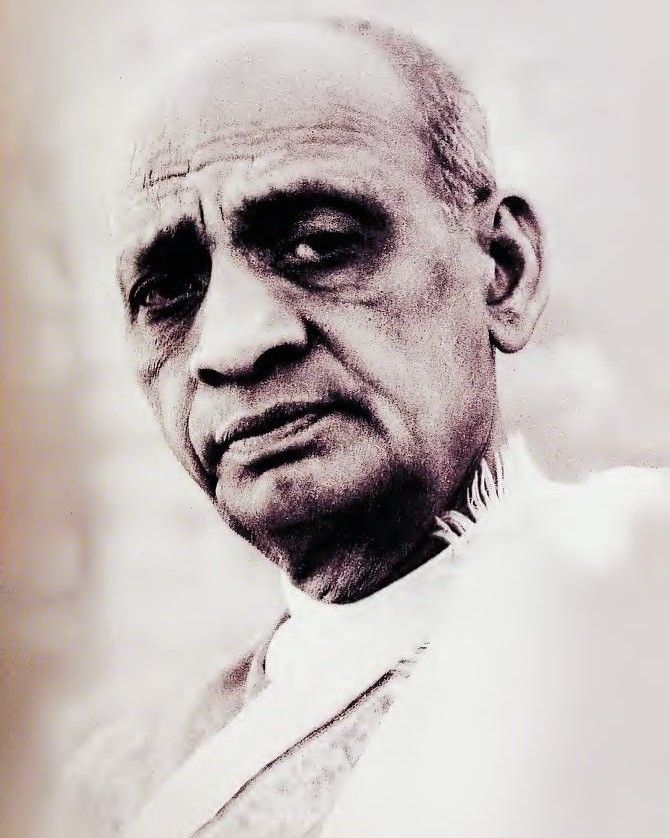
The Bardoli Satyagraha wasn’t just a protest. It was a turning point. It proved that Patel wasn’t just a lawyer—he was a leader of the people.
🔥3: The Fire of Quit India
In 1942, when Gandhi launched the Quit India Movement, the call was clear: British, leave India now. Patel stood beside him, not just in words, but in action.
He was arrested, but his groundwork kept the movement alive. His earlier efforts in organizing local leadership and civil resistance became the backbone of the uprising.
Sardar Vallabhbhai Patel wasn’t just a freedom fighter—he was a strategist of revolution.
🏛️4: The Founder of India’s Administrative Backbone
After independence, chaos loomed. Refugees, riots, and a broken system. Patel knew that freedom without order was fragile.
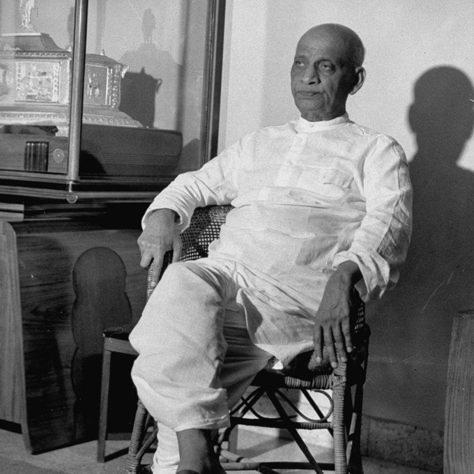
He transformed the colonial bureaucracy into the Indian Administrative Service (IAS)—a disciplined, impartial force that would serve the people, not rulers.
He called it the “steel frame” of India. And today, it still holds the nation upright.
🛡️5: The Symbol of Unity and Strength
Sardar Vallabhbhai Patel didn’t chase power. He carried responsibility. He didn’t speak often—but when he did, the nation listened.
He became the symbol of unity, strength, and discipline. Not through slogans, but through service. Not through politics, but through purpose.
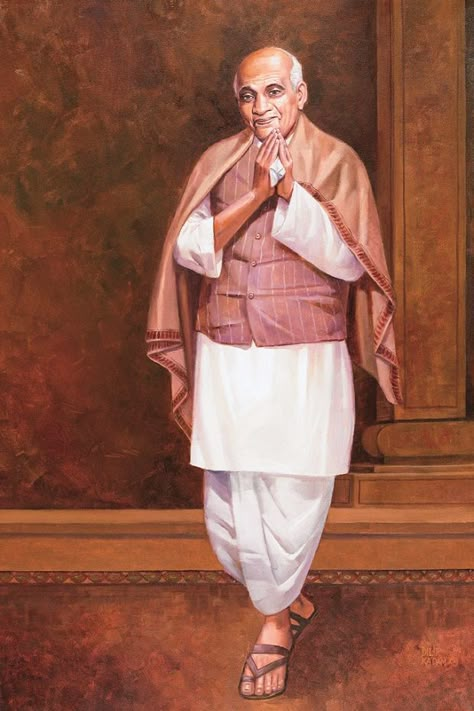
His legacy lives on—not just in books, but in every border he secured, every law he shaped, and every citizen who calls India home.
🛡️ Conclusion: The Iron Legacy of Sardar Vallabhbhai Patel
Sardar Vallabhbhai Patel, often hailed as the Iron Man of India, left behind a legacy that continues to shape the nation’s soul. His contributions went far beyond the battlefield of independence—they laid the foundation for a united, disciplined, and resilient India.
Patel’s greatest achievement was the political integration of 562 princely states into the Indian Union. At a time when India could have splintered into fragments, he used diplomacy, firmness, and strategic brilliance to bring these states together. His vision of a strong, centralized nation was not just political—it was emotional. He believed that unity was India’s destiny, and he made it real.
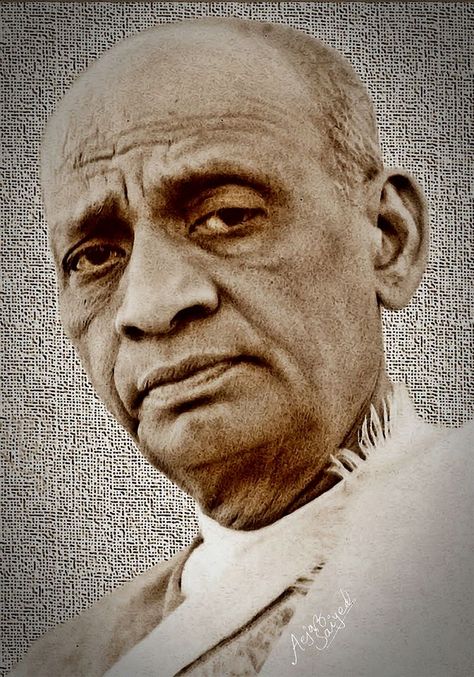
His leadership during the Bardoli Satyagraha showcased his grassroots strength. He didn’t just lead protests—he built movements. The title “Sardar” was not given by politicians, but by the people, in recognition of his courage and commitment.
During the Quit India Movement, Patel’s strategic mind and organizational skills kept the resistance alive even when leaders were jailed. He was the silent force behind the scenes, ensuring that India’s fight for freedom never lost momentum.
After independence, Patel’s role as India’s first Deputy Prime Minister and Home Minister was pivotal. He strengthened the civil services, transforming the colonial bureaucracy into the Indian Administrative Service (IAS)—a professional, impartial force that still holds India together. He advocated for a strong central government, knowing that a young nation needed stability before decentralization.
Despite ideological differences with Nehru, Patel worked closely with him, prioritizing national interest over personal views. Their partnership, though complex, was crucial to India’s survival and growth.
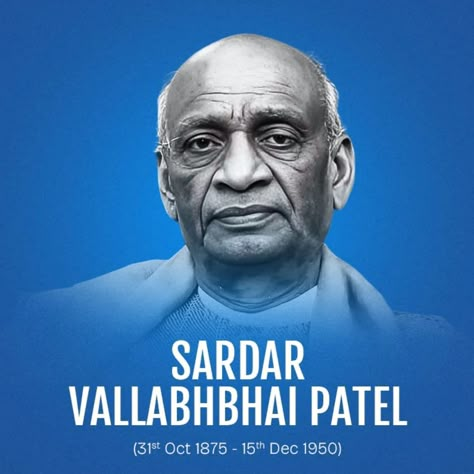
Patel passed away on 15 December 1950, but his legacy lives on. The Statue of Unity in Gujarat, the tallest in the world, stands as a tribute to his towering contributions. More than bronze and concrete, it symbolizes the strength, discipline, and unity he gave India.
Sardar Vallabhbhai Patel was not just a leader—he was a builder. A builder of bridges, institutions, and identity. His legacy is not just remembered—it is lived, every day, in the heartbeat of a united India.
Internal Links: 1.https://historyverse7.com/shivaji-maharaj/ 2.https://historyverse7.com/ashfaqulla-khan/
External Links: 1.https://en.wikipedia.org/wiki/Vallabhbhai_Patel 2.https://inc.in/our-inspiration/sardar-vallabhbhai-patel
📘 FAQ: Understanding Sardar Vallabhbhai Patel
1. Why did Sardar Vallabhbhai Patel prioritize unity over popularity in post-independence India?
Answer:
Because Patel believed that a fragmented India would never survive. He didn’t chase applause—he chased stability. While others debated ideologies, Sardar Vallabhbhai Patel focused on integrating princely states, calming communal tensions, and building administrative strength. His decisions weren’t always popular, but they were necessary. For him, unity wasn’t a slogan—it was survival.
2. What personal qualities made Patel the ideal choice for integrating 562 princely states?
Answer:
Three traits: discipline, decisiveness, and emotional intelligence. Patel could read a room, sense hesitation, and respond with either warmth or firmness. He treated princes with respect but never let ego derail national interest. His ability to balance diplomacy with steel made him the only leader who could stitch India together without bloodshed.
3. How did Patel’s rural upbringing influence his leadership style?
Answer:
Patel’s roots in a farming family taught him patience, grit, and humility. He understood the pulse of the common man. His speeches were simple, his actions direct. He didn’t lead from ivory towers—he led from the soil. That’s why farmers, workers, and villagers trusted him. His leadership wasn’t learned—it was lived.
4. Why is the Statue of Unity more than just a monument?
Answer:
Because it’s not just bronze—it’s India’s promise to never forget its backbone. The Statue of Unity stands tall not for Patel’s fame, but for his function. It reminds every citizen that strength lies in unity, and that one man’s resolve can shape a nation. It’s a tribute to action, not just memory.
5. What would India look like today without Sardar Vallabhbhai Patel’s leadership?
Answer:
It’s chilling to imagine. Without Patel, India might have splintered into dozens of independent kingdoms. There would be no unified map, no strong center, and no administrative backbone. Patel didn’t just help India win freedom—he helped it hold together. His absence would have meant chaos. His presence meant cohesion.
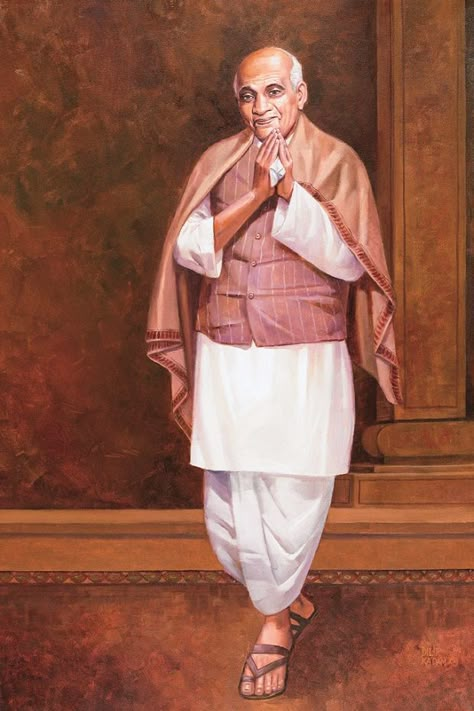
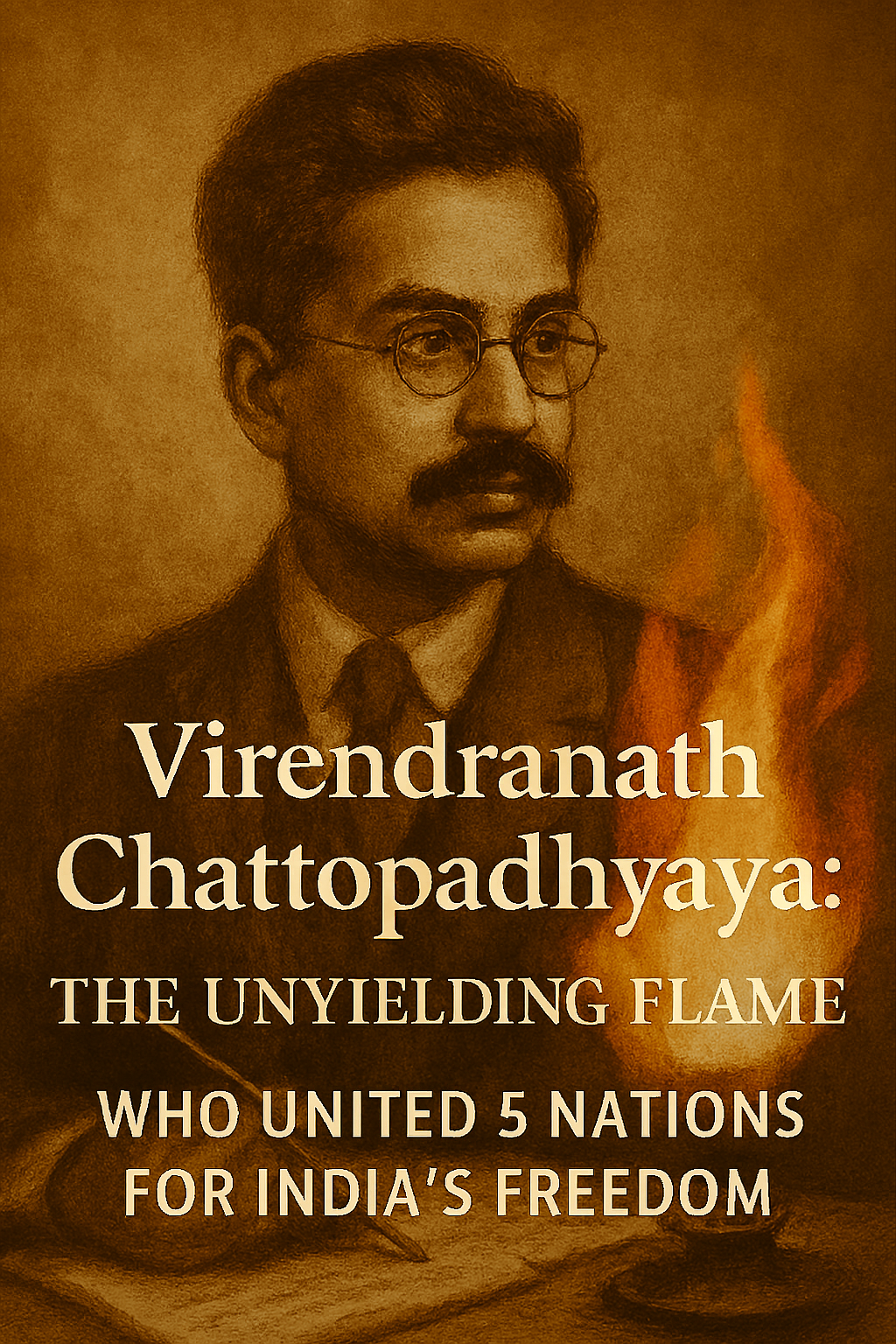
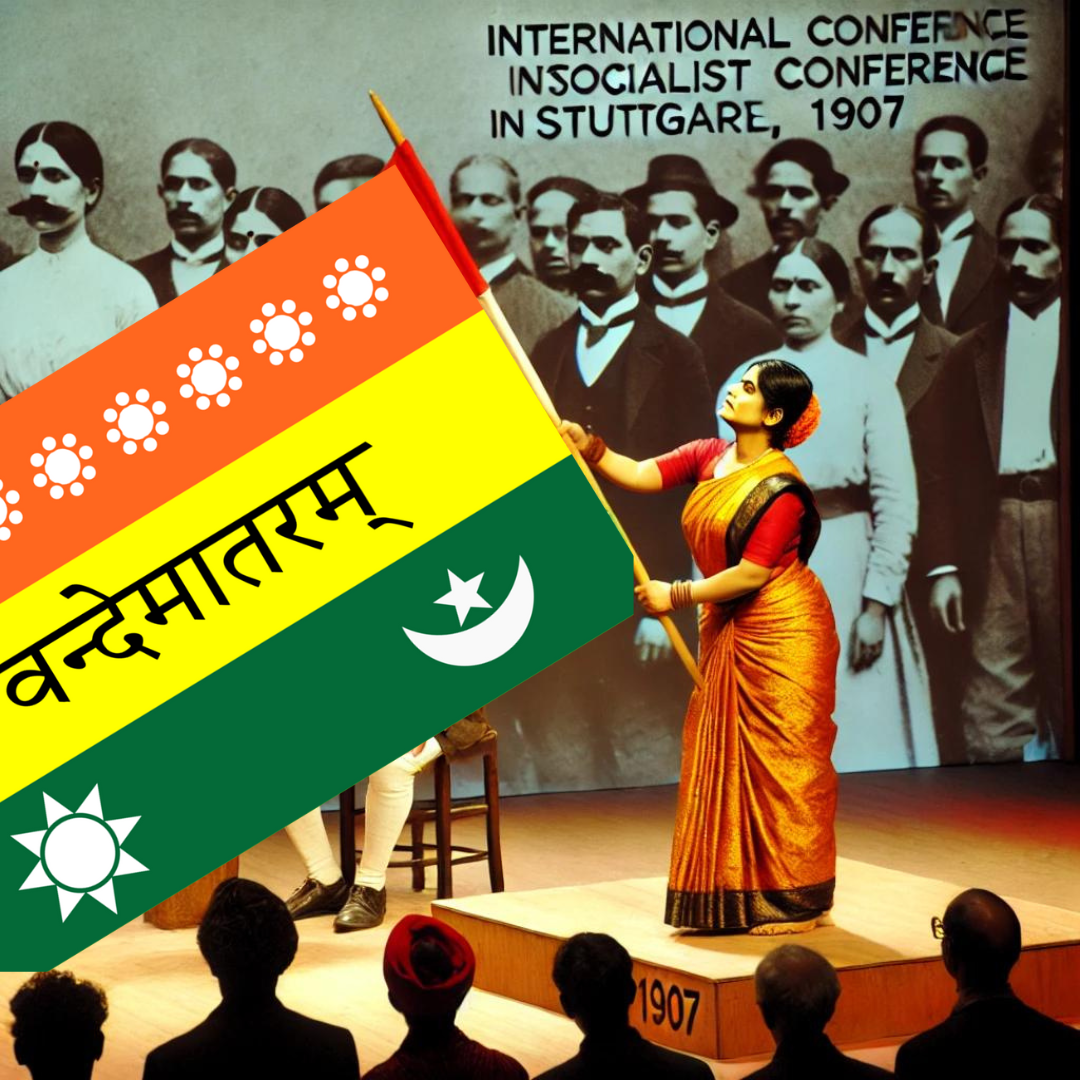
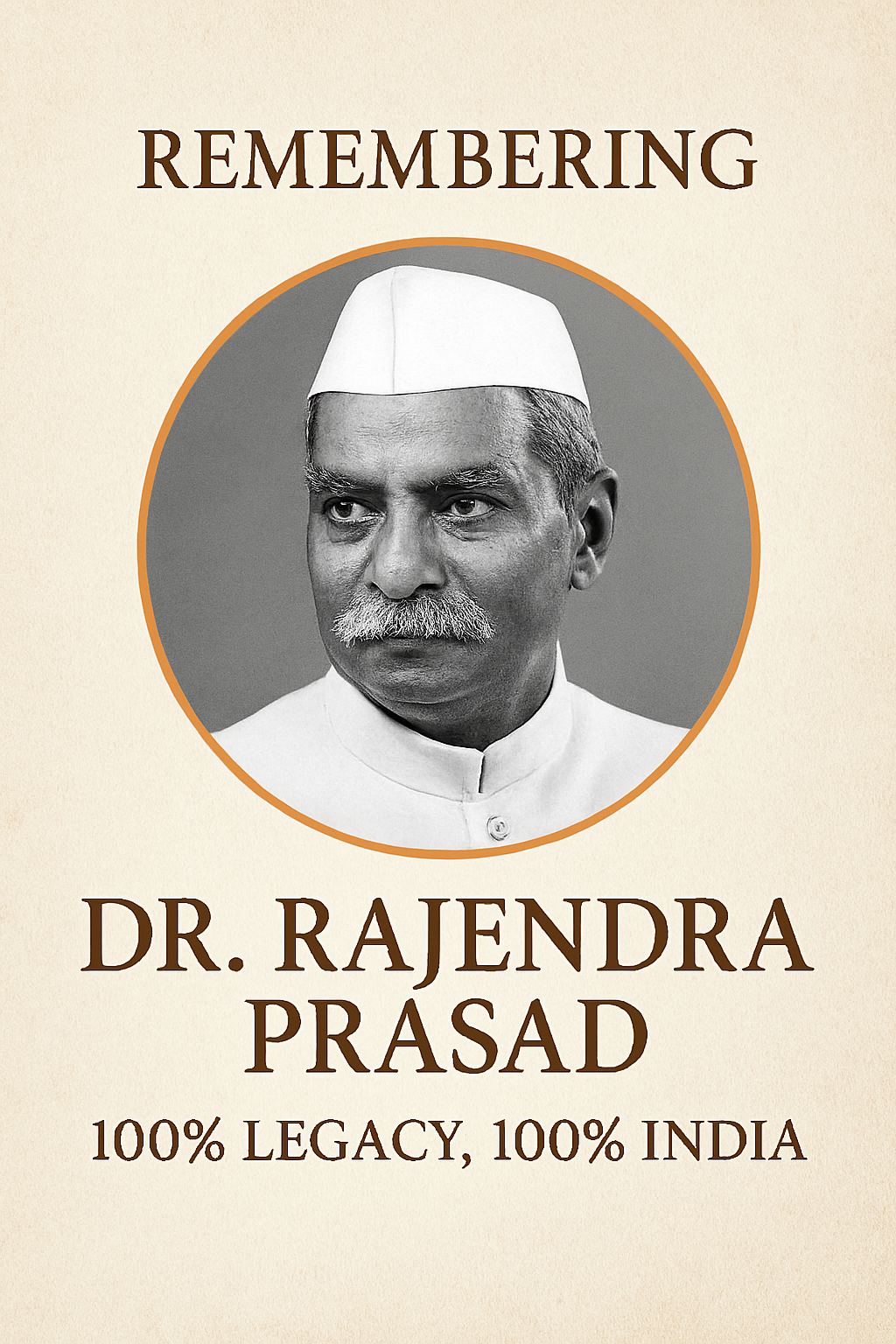
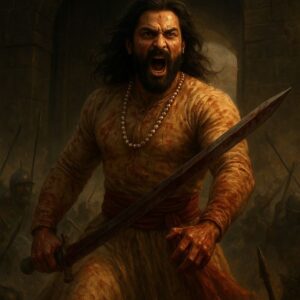
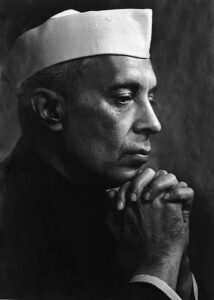
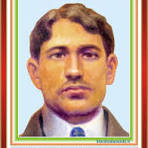
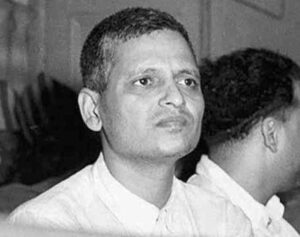
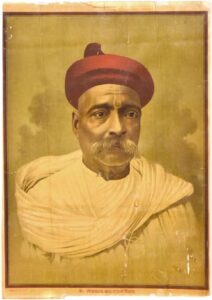
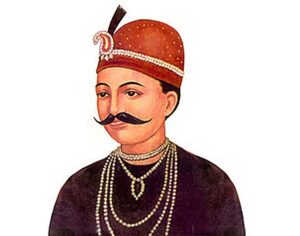
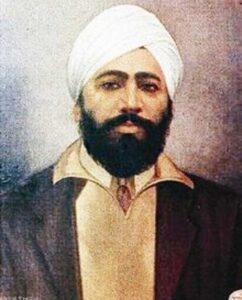
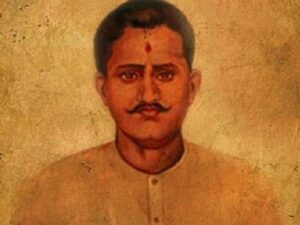
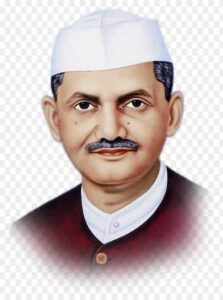
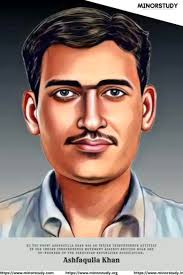
2 comments